
Therapsida is a major group of eupelycosaurian synapsids that includes mammals, their ancestors and relatives. Many of the traits today seen as unique to mammals had their origin within early therapsids, including limbs that were oriented more underneath the body, as opposed to the sprawling posture of many reptiles and salamanders.
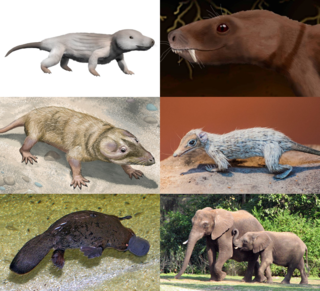
Cynodonts are a clade of eutheriodont therapsids that first appeared in the Late Permian, and extensively diversified after the Permian–Triassic extinction event. Cynodonts occupied a variety of ecologies, including as carnivores and herbivores. Mammals are cynodonts, as are their extinct ancestors and close relatives, having evolved from advanced probainognathian cynodonts during the Late Triassic. All other cynodont lines went extinct, with the last known non-mammalian cynodont group, the Tritylodontidae, having its youngest records in the Early Cretaceous.

Eucynodontia is a clade of cynodont therapsids including mammals and most non-mammalian cynodonts. The oldest eucynodonts are known from the Early Triassic and possibly Late Permian. Eucynodontia includes two major subgroups, Cynognathia and Probainognathia.
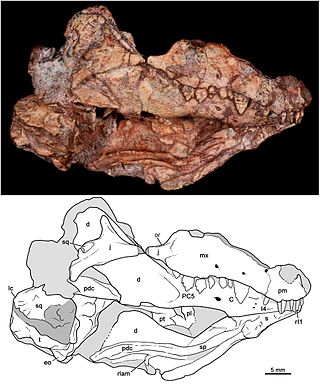
Probainognathidae is an extinct family of insectivorous cynodonts which lived in what is now South America during the Middle to Late Triassic. The family was established by Alfred Romer in 1973 and includes two genera, Probainognathus from the Chañares Formation of Argentina and Bonacynodon from the Dinodontosaurus Assemblage Zone of Brazil. Probainognathids were closely related to the clade Prozostrodontia, which includes mammals and their close relatives.
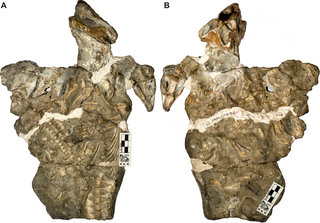
Galesaurus is an extinct genus of carnivorous cynodont therapsid that lived between the Induan and the Olenekian stages of the Early Triassic in what is now South Africa. It was incorrectly classified as a dinosaur by Sir Richard Owen in 1859.

The theriodonts are a major group of therapsids which appeared during the Middle Permian and which includes the gorgonopsians and the eutheriodonts, itself including the therocephalians and the cynodonts.

Theriognathus is an extinct genus of therocephalian therapsid belonging to the family Whaitsiidae, known from fossils from South Africa, Zambia, and Tanzania. Theriognathus has been dated as existing during the Late Permian. Although Theriognathus means mammal jaw, the lower jaw is actually made up of several bones as seen in modern reptiles, in contrast to mammals. Theriognathus displayed many different reptilian and mammalian characteristics. For example, Theriognathus had canine teeth like mammals, and a secondary palate, multiple bones in the mandible, and a typical reptilian jaw joint, all characteristics of reptiles. It is speculated that Theriognathus was either carnivorous or omnivorous based on its teeth, and was suited to hunting small prey in undergrowth. This synapsid adopted a sleek profile of a mammalian predator, with a narrow snout and around 1 meter long. Theriognathus is represented by 56 specimens in the fossil record.
Cynosaurus is an extinct genus of cynodonts. Remains have been found from the Dicynodon Assemblage Zone in South Africa. Cynosaurus was first described by Richard Owen in 1876 as Cynosuchus suppostus. Cynosaurus has been found in the late Permian period. Cyno- is derived from the Greek word kyon for dog and –sauros in Greek meaning lizard.

Platycraniellus is an extinct genus of carnivorous cynodonts from the Early Triassic. It is known from the Lystrosaurus Assemblage Zone of the Normandien Formation in South Africa. P. elegans is the only species in this genus based on the holotype specimen from the Ditsong National Museum of Natural History in Pretoria, South Africa. Due to limited fossil records for study, Platycraniellus has only been briefly described a handful of times.

Lumkuia is an extinct genus of cynodonts, fossils of which have been found in the Cynognathus Assemblage Zone of the Beaufort Group in the South African Karoo Basin that date back to the early Middle Triassic. It contains a single species, Lumkuia fuzzi, which was named in 2001 on the basis of the holotype specimen BP/1/2669, which can now be found at the Bernard Price Institute in Johannesburg, South Africa. The genus has been placed in its own family, Lumkuiidae. Lumkuia is not as common as other cynodonts from the same locality such as Diademodon and Trirachodon.
Boreogomphodon is an extinct genus of traversodontid cynodonts from the Late Triassic of the eastern United States. Fossils have been found from the Turkey Branch Formation in Virginia.
Scalenodon is an extinct genus of traversodontid cynodonts from the Middle Triassic of Africa and possibly Russia. The type species S. angustifrons was named in 1946 and several other species were named in the following years. Most of the species from Africa are now thought to belong to different genera than Scalenodon.
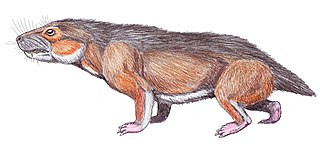
Eutheriodontia is a clade of therapsids which appear during the Middle Permian and which includes therocephalians and cynodonts, this latter group including mammals and related forms.

Prozostrodontia is a clade of cynodonts including mammaliaforms and their closest relatives such as Tritheledontidae and Tritylodontidae. It was erected as a node-based taxon by Liu and Olsen (2010) and defined as the least inclusive clade containing Prozostrodon brasiliensis, Tritylodon langaevus, Pachygenelus monus, and Mus musculus. Prozostrodontia is diagnosed by several characters, including:
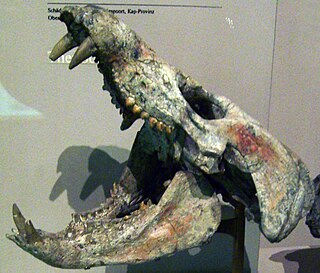
Gomphodontia is a clade of cynognathian cynodonts that includes the families Diademodontidae, Trirachodontidae, and Traversodontidae. Gomphodonts are distinguished by wide and closely spaced molar-like postcanine teeth, which are convergent with those of mammals. Other distinguishing characteristics of gomphodonts include deep zygomatic arches, upper postcanines with three or more cusps spanning their widths and lower postcanines with two cusps spanning their widths. They are thought to have been herbivorous or omnivorous. Gomphodonts first appeared in the Early Triassic and became extinct at the end of the Late Triassic. Fossils are known from southern Africa, Argentina and southern Brazil, eastern North America, Europe, China, and Antarctica.
Mandagomphodon is an extinct genus of traversodontid cynodonts from the Middle Triassic Lifua Member of the Manda Beds of Ruhuhu Valley, Tanzania. The type species Mandagomphodon hirschsoni was named by Crompton in 1972 as a species referable to Scalenodon. Later studies, including a 2003 phylogenetic analysis of traversodontid relationships, did not find the species of Scalenodon from the Manda Formation to form a single clade, meaning that many were not referable to the genus. The study suggested that S. hirschsoni had more in common with other traversodontids like Luangwa. S. attridgei was viewed as a possible synonym of S. charigi, which was also found to be only distantly related to S. angustifrons. Therefore, a new generic name Mandagomphodon was erected for S. hirschsoni by James A. Hopson in 2013.

Cricodon is an extinct genus of trirachodontid cynodonts that lived during the Early Triassic and Middle Triassic periods of Africa. A. W. Crompton named Cricodon based on the ring-like arrangement of the cuspules on the crown of a typical postcanine tooth. The epithet of the type species, C. metabolus, indicates the change in structure of certain postcanines resulting from replacement.
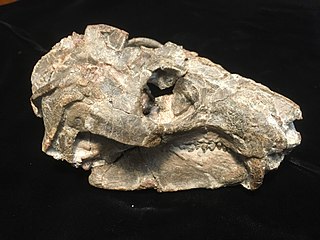
Aleodon is an extinct genus of cynodonts that lived from the Middle to the Late Triassic. Relatively few analyses have been conducted to identify the phylogenetic placement of Aleodon, however those that have place Aleodon as a sister taxon to Chiniquodon. Two species of Aleodon are recognized: A. brachyramphus which was discovered in Tanzania, and A. cromptoni which was discovered most recently in Brazil.
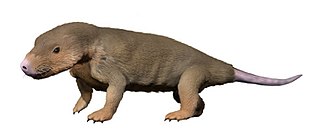
Abdalodon is an extinct genus of late Permian cynodonts, known by its only species A. diastematicus.Abdalodon together with the genus Charassognathus, form the clade Charassognathidae. This clade represents the earliest known cynodonts, and is the first known radiation of Permian cynodonts.
Vetusodon is an extinct genus of cynodonts belonging to the clade Epicynodontia. It contains one species, Vetusodon elikhulu, which is known from four specimens found in the Late Permian Daptocephalus Assemblage Zone of South Africa. With a skull length of about 18 centimetres (7.1 in), Vetusodon is the largest known cynodont from the Permian. Through convergent evolution, it possessed several unusual features reminiscent of the contemporary therocephalian Moschorhinus, including broad, robust jaws, large incisors and canines, and small, single-cusped postcanine teeth.





















